WHERE YESTERDAY’S SEWAGE OVERFLOWS FLOWED 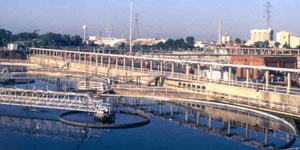 Yesterday’s floodwater caused diluted sewage releases from the 69th St. Wastewater Treatment Plant, located near the crossing of 69th St. over Buffalo Bayou (just upstream from the new Buffalo Bend Nature Park and the Port of Houston Turning Basin). Houston Public Media notes the city’s rundown on where and how much: “The estimated volume of released wastewater as of 6 p.m. Wednesday was approximately 500,000 gallons at Halls Bayou at US 59 at Parker Rd.; approximately 160,000 gallons at White Oak Bayou Near Interstate 45 N. at Wrightwood St.; and approximately 500,000 gallons at Buffalo Bayou near the University of Houston Downtown, officials said.” The city also says anybody using their own private water wells in those areas should get them checked out (and boil water in the meanwhile). The 69th St. plant is the city’s largest wastewater facility, as well as a production site of Hou-Actinite fertilizer. [Houston Public Media; previously on Swamplot] Photo of 69th St. Wastewater Treatment Plant: Webber
Yesterday’s floodwater caused diluted sewage releases from the 69th St. Wastewater Treatment Plant, located near the crossing of 69th St. over Buffalo Bayou (just upstream from the new Buffalo Bend Nature Park and the Port of Houston Turning Basin). Houston Public Media notes the city’s rundown on where and how much: “The estimated volume of released wastewater as of 6 p.m. Wednesday was approximately 500,000 gallons at Halls Bayou at US 59 at Parker Rd.; approximately 160,000 gallons at White Oak Bayou Near Interstate 45 N. at Wrightwood St.; and approximately 500,000 gallons at Buffalo Bayou near the University of Houston Downtown, officials said.” The city also says anybody using their own private water wells in those areas should get them checked out (and boil water in the meanwhile). The 69th St. plant is the city’s largest wastewater facility, as well as a production site of Hou-Actinite fertilizer. [Houston Public Media; previously on Swamplot] Photo of 69th St. Wastewater Treatment Plant: Webber
Magnolia Park
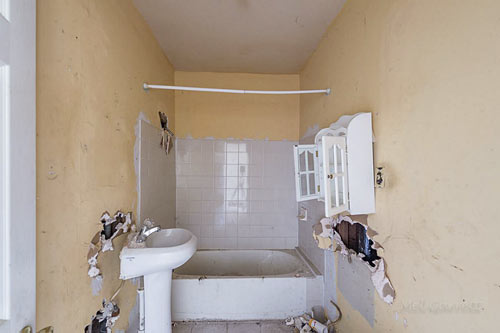
- 7617 Ave. I [HAR]
BIDS TO BUY LAW ENFORCEMENT HS PUNISHED FOR NOT FOLLOWING RULES 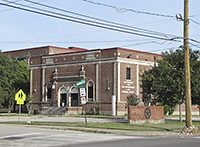 HISD gave a unanimous no today to those competing bids from nearby St. Thomas High School and developer AV Dickson Street to buy the High School for Law Enforcement and Criminal Justice in Magnolia Grove. Apparently, the reason the offers for the 11-acre campus at 4701 Dickson St. were rejected had less to do with the numbers than with HISD’s preferred S.O.P.: “[T]he board’s attorney, David Thompson, stated immediately afterward that both bidders had violated the district’s ‘code of silence’ policy, which prohibits communication between trustees and those with pending business before them.” Superintendent Terry Grier tells the Houston Chronicle that the building will be going right back on the market: “Hopefully if we do that, the bidders will take our ethics policy seriously.” [Houston Chronicle; previously on Swamplot] Photo: HISD
HISD gave a unanimous no today to those competing bids from nearby St. Thomas High School and developer AV Dickson Street to buy the High School for Law Enforcement and Criminal Justice in Magnolia Grove. Apparently, the reason the offers for the 11-acre campus at 4701 Dickson St. were rejected had less to do with the numbers than with HISD’s preferred S.O.P.: “[T]he board’s attorney, David Thompson, stated immediately afterward that both bidders had violated the district’s ‘code of silence’ policy, which prohibits communication between trustees and those with pending business before them.” Superintendent Terry Grier tells the Houston Chronicle that the building will be going right back on the market: “Hopefully if we do that, the bidders will take our ethics policy seriously.” [Houston Chronicle; previously on Swamplot] Photo: HISD

- 7838 Baltimore St. [HAR]
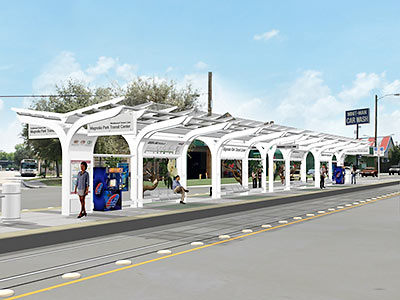
In honor of “nearly” reaching what it describes as the halfway point in constructing the new East End light-rail line, Metro is releasing this rendering showing what it’ll look like when riders reach the track’s end. It’s a view of the station at the Magnolia Park Transit Center on Harrisburg at 70th St., the line’s easternmost reach. For the most part, the basic structure of each station will be identical steel constructions with glass canopies — much as they are on the existing Main St. line.
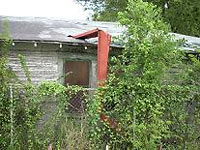 John Nova Lomax chronicles another pedestrian adventure with drummer pal David Beebe in Houstoned—this time through desolate pockets of Houston’s East Side. Their potion-and-perspiration-soaked journey begins at the southern end of the Fifth Ward.
John Nova Lomax chronicles another pedestrian adventure with drummer pal David Beebe in Houstoned—this time through desolate pockets of Houston’s East Side. Their potion-and-perspiration-soaked journey begins at the southern end of the Fifth Ward.
There, on the corner of Lyons Avenue and McKee, a dry-heaving stray dog in its death throes welcomed us to central Houston’s Chernobyl, a cursed warren of rusty train tracks, crumbling warehouses, and whole blocks that have reverted to wild coastal prairie.
Ruins of an entire neighborhood molder back here – unpainted shotgun shacks collapsing in on themselves scattered around a blocky brick building that looked like it was once a bar or liquor store. It had been stripped of all metal fixtures by street urchins and cut off from the electrical grid, but a sign in the window indicated it was for sale. “Call Bob,†it said. And evidently it was not so long ago a place of some importance, as a street teamer for a rapper named Marcelo had plastered a few promo posters on its door.
Next stop: Clinton Dr., where the “rank stench” of the 69th Street Wastewater Treatment Plant guides their path.
Lord have mercy on Clinton Drive. Save for a couple of islands of activity like the huge fenced-in KBR headquarters (which is rumored to be for sale), Clinton is now little more than a decrepit strip of ruined factories, warehouses fast crumbling into rubble, and decaying 1950s office buildings with broken windows and mold-stained walls.
It reminded me of 19th Century British gadfly William Cobbett’s description of the village of Deal, Sussex: “Deal is a most villainous place. It is full of filthy looking people. Great desolation of abomination has been going on here; tremendous barracks, partly pulled down and partly tumbling down and partly occupied by soldiers. Everything seems upon the perish. I was glad to hurry along through it…â€
It wasn’t always such. From the Ship Channel’s opening until the advent of containerized shipping in the early ‘80s, Clinton and surrounding streets were bustling by day and by night, dotted with rice beer-soaked bars with names like the Cesspool, the Worker’s Bar, the Seafarer’s Retreat, the Mermaid Café, Tater’s Last Chance and Dottie’s Snug Harbor.
In those days, it could take a week to unload a cargo ship, and for much of that time, sailors were free to roam the port, dine in the restaurants, carouse in the bars, and find companionship where they may. The same went for the thousands of shore-based workers – the mechanics, channel pilots, stevedores, and tug boat crews.
Neighborhood on the waterfront: Coulda been a contender.
- The East End Trek [Houstoned]
Photo: David Beebe and John Nova Lomax

